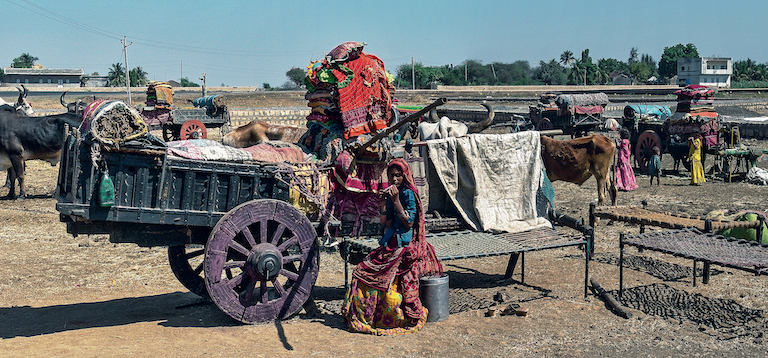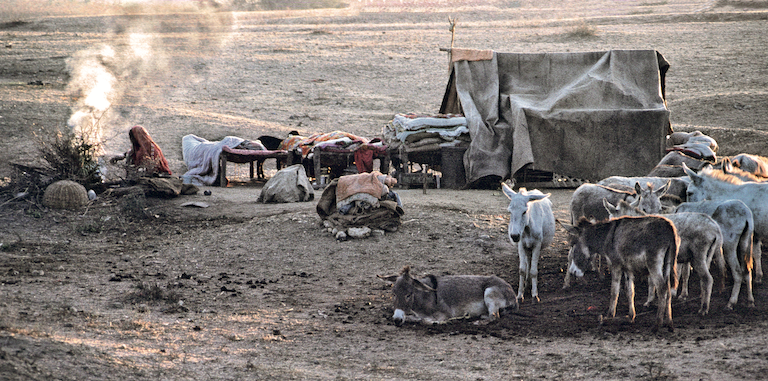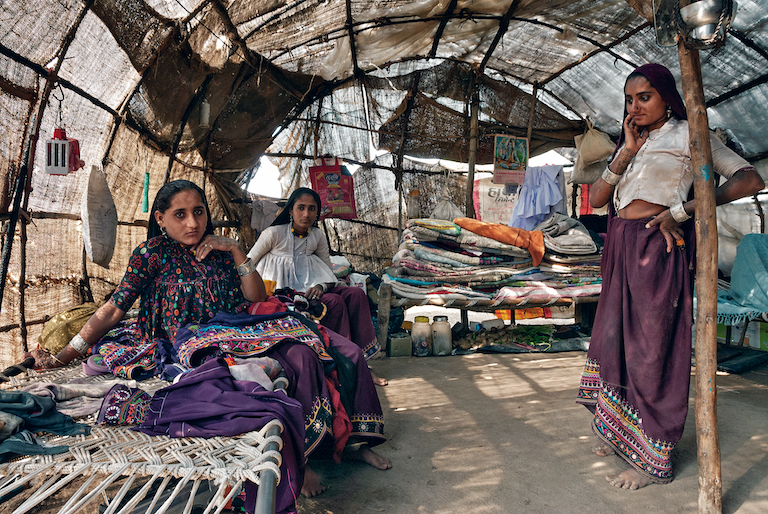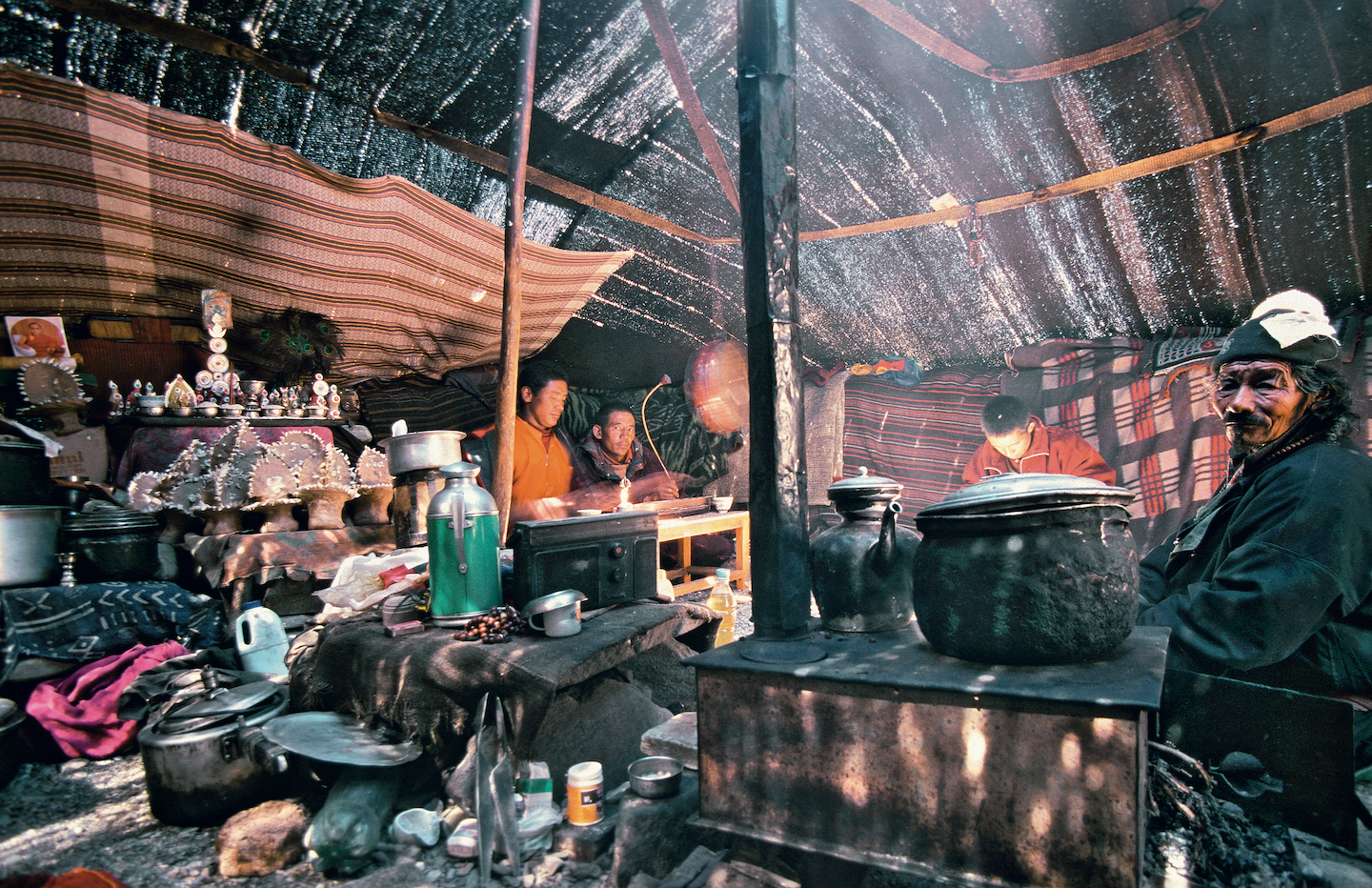This book is on traditional residential architecture but it is interesting to explore how nomadic and itinerant tribes and castes of India organize camps for their living – a part of their interesting lifestyles and a form of temporary residence for many such people of India.
India is host to many nomadic tribes, particularly in western India and the Himalayas. In India they are called khanabadosh, a word of Persian origin, meaning those who carry their homes on their shoulders. They are also called pakhiwasi, or those who stay in camps.
Tribes like jugglers, bards, magicians, snake-charmers, genealogists and the like pitch camps on the outskirts of towns and villages and go into the habitation to interact with locals and their patrons. Professional artisans too, like wandering blacksmiths, basket and mat weavers also do likewise and after catering to the requirements of a town they move on. Nomadic tribes or pastoralists wander with their animals in search of pasture lands and have a regular annual cycle – leaving their semi-arid regions at the onset of summer when they move to irrigated regions, returning home just before the monsoons, hoping for good grass for their herds. Earlier there were also wandering trading communities who bartered and traded goods in the Himalayas between India and China, or those like the Banjara traders of the north-west Indian plains. The Banjaras were also suppliers of victuals to armies and their camps used to be heavily guarded to protect their goods, with their bullock-carts parked in a circular manner for defensive purposes.

A camp of itinerant Gadia Lohar blacksmiths in Junagadh district, Gujarat. Their name literally means blacksmiths-with-carts. They wander in the rural as well as urban countryside doing job-work, with all their belongings piled high in wooden carts. They originated from Rajasthan but are now found all over western India. They camp under the sky and every few days hit the road again for more job-work.
While some of these are fully wandering tribes, most have houses where they return to as a part of an annual cycles for marriage and community functions. Some walk on foot with pack camels or donkeys carrying their household goods. The Gadia Lohars (literally meaning blacksmiths-with-carts) carry their belongings on carts with wooden wheels on which they cover hundreds of miles every year. The wandering route of performing itinerants is normally shorter and they camp for days continuously on the outskirts of towns. The herders and shepherds too return to their homes before the monsoons and some of their huts are illustrated in the this work for the states of Rajasthan and Gujarat. However, different wandering tribes have distinct camp styles.
The Gadia Lohars pitch their camps around a fire with their carts. If they are staying at a village for a considerable number of days they will even make mud enclosures around their carts. The Bharwad pastoralists of western Gujarat surround their camps with thorny bushes where they put their animals for the night after they come back from grazing while one corner has all their belongings neatly piled on to a cot.

The Banjara are wandering traders and artisans. They also do levelling of fields with their donkeys. Above: An Od family of Gujarat on the move. They move with their belongings, including their poultry tied to cots placed on donkeys. The Od are also earth-workers of Gujarat in western India.
Some shepherds and camel herders like the Rajasthani Rabari have a separate enclosure of thorny bushes for their animals while they themselves pitch camp in a clearing in a field. They often have working arrangements with local farmers to use their fields after harvest so that the droppings of their animals serve as good manure for the fields. They return to their native areas at the end of the year to shear wool from their animals for sale.
The Rabaris of Gujarat come mainly from the district of Kachchh though a considerable number of a different sub-group, the Patania Rabaris, used to live on the outskirts of big towns of central Gujarat. The Kachchhi Rabaris live in huts in Kachchh with exquisite mud-work called lippankam, but on their journeys camps are frugal. The men leave with the animals in the morning and it is left to the hard-working women to daily pack their belongings, walk and pitch camp for the night at the next halt and cook food for their families, only to start again the next morning. They prefer open camps under the night sky and through winter and summer they wear outfits of handloom cloth made from hand-spun yarn from the wool of their animals. This cloth is dyed black with tie-and-dye motifs and designs. Lean-tos made for protecting them from the elements are also made from this cloth.

Charan huts, Gujarat.They are made of bent bamboo strips covered with fabric made from discarded jute gunny bags or twigs, supported by a pole in the center. These light structures used by these nomadic communities are easy to dismantle and transport in their wanderings.
The material used for the tents and camps of Khanabadosh wanderers depend on local availability. The nomads of the Himalayas use tents made from yarn hand-spun from yak hair. As it is loosely spun it lets in a fair amount of light and provides for natural ventilation. Mat-makers naturally use their raw material to make temporary thatched huts. Since reeds are available in western Kachchh, the Fakirani Jath use them to make reed-huts. The Charan of Gujarat make the frame of their hut from wood pieces or bamboo and cover it with sackcloth. The Banjaras with their pack animals use tents for the winter nights with their animals tied outside.
The working space of their camps is plastered with mud to give a smooth finish and to keep it clean. Temporary partitions with mud and twigs are used to give some privacy in their wandering lives, especially since they do not have windows to shut out the world and prying eyes. The availability of modern materials has altered this and for camping itinerants have started using regular tents bought from markets. Their itinerant lifestyles, moreover, are slowly vanishing as they are getting more and more ‘settled’, with a transition to modern professions 🟥
